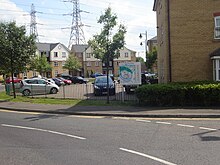Enfield Island Village: Difference between revisions
Northmetpit (talk | contribs) →Gallery: Added images |
Northmetpit (talk | contribs) →Gallery: Added images |
||
| Line 45: | Line 45: | ||
Image:Enfield Island Village9.JPG| Road bridge spanning the [[River Lee Navigation]] |
Image:Enfield Island Village9.JPG| Road bridge spanning the [[River Lee Navigation]] |
||
Image:Enfield Island Village10.JPG| The Pattern Room |
|||
Image:Royal Small Arms Factory.jpg| The machine shop |
|||
Revision as of 15:31, 9 June 2008


Enfield Island Village is a large housing development in Enfield close to Enfield Lock. Until 1993, its site was mostly in Essex in the Epping Forest (district), parish of Waltham Abbey, hamlet of Sewardstone. It was built on land previously occupied by the Royal Small Arms Factory. The village is close to the borders of Essex and Hertfordshire and adjacent to the River Lee Navigation, River Lea, Cattlegate Flood Relief Channel, Newmans Weir to the north and open countryside, especially Epping Forest.
The housing estate was built by Fairview New Homes between 1997-2003 on a 100 acre, brown field, flood plain, and comprises a mixture of social housing, flats,houses and some of the original buildings have been retained. The village has a central parkland area and a small shopping centre. The shops include a small supermarket -Tesco Express, a pharmacy and a Chinese takeaway. The Island also has its own General practitioner (GP), private fitness centre , NHS dental access centre and a new (2003) primary school - Keys Meadow in nearby Enfield Lock. A new library is due to open in 2008.
There was a campaign against the development by Friends of the Earth and the Enfield Lock Action Group in the late 1990s. This is reflected in the 'Controversy' section below. The campaign resulted in the Enfield RSAF (Royal Small Arms Factory) Review Panel being set up, informed by environmental reports carried out over ten years and including evidence from witnesses including the Head of Land Quality at the Environment Agency and a team of environmental consultants. The review concluded that the site was safe for development and that rumours of dangerous materials by campaigners were untrue.
Planning permission was granted for the development, supported by the European Union and by the Enfield Enterprise Agency. It was developed as a model brown field development, with a clay cap at a depth of one metre under the topsoil. All inspections of the clay cap have been successfully completed and there have been no reports of contamination up to the present (May 2008). Social development of the new community has been the subject of research by Middlesex University.
As a private development, residents are responsible for many aspects of life on the Island through the Enfield Island Village Residents' Association. It is responsible for the upkeep of common land, including the ornamental canal and parkland, utlities such as the waste water system, and for enforcing legal covenants covering the development.


Controversy
The site was decommissioned by the MOD in 1984 and was sold to British Aerospace (BAe). BAe together with Trafalgar House launched a joint venture company- Lee Valley Developments (LVD). Limited tests were carried out on the contaminated land. In 1996 the land was sold to the housing wing of Hillsdown Holdings, Fairview Homes.
In the original plans the local council imposed a limit on the number of homes before shops and community services were provided, but this was later withdrawn. The developers also increased housing density from their initial plans, with a higher proportion (25%) of social accommodation and some homes to asylum seekers [1]. The area was featured in a 2000 investigation by BBC programme Panorama into housing estates on contaminated land. It reported that a survey found traces of lead, cadmium, arsenic, copper. The land has been "remediated" by capping with a layer of clay to prevent contaminants leaching to the surface, but there have been reports of children suffering dermatological problems after handling soil from their gardens, residents have been warned not dig more than three feet down. There was further disquiet when Martin Jarvis London Borough of Enfield's chief planning officer left to join Fairview as a director. The borough subsequently convened a special panel to investigate the various allegations surrounding the project, which were refuted as "unsubstantiated rumours". However, "robust and permanent" monitoring of the site was recommended for the future and the report was narrowly adopted by the council. [1]
Historically inspections have been completed every six months. It has been agreed with the London Borough of Enfield that phases that have been subject to five or more years of inspections can be reduced to annual monitoring only. However, phases which have not been subject of long term monitoring, therefore the current inspection December 2007 has targeted these areas only. The next inspection will be in April 2008 and will inspect all phases of the development.
Following the last inspection in December 2007, Enviros Consulting Ltd consider that the integrity of the cap has not been affected by the ongoing occupation of the island and no issues have been raised. [2]
Further reading
- de Zylva. P. et al, Unsafe as Houses: Urban Renaissance or Toxic Timebomb? Friends of the Earth & Enfield Lock Action Group, 2000 ISBN 1857503295
- Sinclair. I, London Orbital pp56-62, 2002 Granta Books ISBN 1862075476
Nearest Places
Nearest stations
Gallery
-
James Lee square
-
Former police station
-
Watertower on the island
-
Road bridge spanning the River Lee Navigation
-
The Pattern Room
-
The machine shop
References
- ^ a b Hidden london Retrieved April 14 2008
- ^ Environmental report- December 2007 Retrieved April 30 2008








